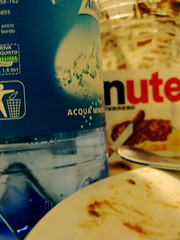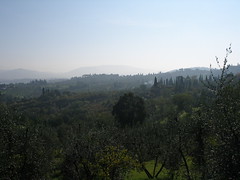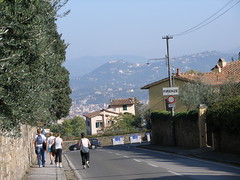Environmental Studies Waived in Oil Push
By JOHN HEILPRIN, Associated Press WriterTue Oct 18, 7:49 PM ET
WASHINGTON - In an aggressive push by the Bush administration to open more public land to oil and gas production, the Interior Department has quit conducting environmental reviews and seeking comments from local residents every time drilling companies propose new wells. Read article...
http://news.yahoo.com/s/ap/20051018/ap_on_go_pr_wh/drilling_public_lands
Thursday, October 20, 2005
News: "Environmental Studies Waived in Oil Push"
Sunday, October 16, 2005
Mangiare Firenze
All of a sudden I broke into a state of deranged laughter and tears: Dio mio, what a big world we have! How ironic this is, how right it is, how different it is, how it is just such--just the way it is. If you have ever lived abroad you likely know what I’m talking about; if not, you will have to live abroad to understand.
I finished my pasta and drank my frizzante; the little earbuds I never use plugged into me. In an embarrassing display I finished off the bottom of the Nutella bottle I was savoring. I tried to get every last drop so as to not waste any of the commercial product I have become so addicted to. Nutella is very good, and very addictive.
Last night I had the biggest pang of a longing to stay here. I decided in that moment that I didn’t want to leave. I was sitting with my Italian friends, speaking my semi-broken, nicely improving Italian, drinking a mixed drink, eating free buffet in the locali right at the edge-corner of Piazza Beccaria, slowly becoming more attached to my seat.
We spoke about food in Italy and the USA; we spoke about the culture around it. We spoke about politics and culture and Italy and the USA. I was asked what the typical American cose da mangiare is. Immediately I laughed and thought of the hamburger. If they wanted to see the garbage of American cuisine look no farther than McDonalds. “We don’t really like American cose da mangiare. I can’t see the hamburger being the only thing people eat,” I heard. But I then caught myself and mentioned that USA is much more of a melting pot and its diversity is something quite special and important to remember. I love Asian food and Mexican food, for example, I said. “We love to eat sushi, and lots of it! But our Italian cose da mangiare is important to us.” Italians are lucky, I heard, to have such a beautiful flavor in their own living.
My Italian friends are very nice.
We had a very good time. After wandering the streets and getting gelato, we went to their apartment (with a truly stunning balcony view of the flood-lit Palazzo Vecchio), and socialized. I got nostalgic about my early college years. I was served a small glass of Martini. Two of my friends had very small glasses of Martini after having some apricot juice. All of them shared one beer. And before we left the apartment we had some water. This was really something, so different from the USA, such an opposite! I couldn’t help but comment on this difference, it was really quite funny. I enjoyed myself a lot.
I’m just this simple American guy abroad, the foreigner learning new ways of seeing, new ways of learning, new ways of listening, new ways of talking, new ways of walking, new ways of breathing and laughing. And to think: this is only Florence, this is only Italy, only one of the world’s infinite worlds.
This morning I went with some schoolmates on a hike into the hills behind Boboli Garden and Piazzale Michelangelo. It was not a hike in the same sense as what one would think in California; there was only a small wooded area we walked through. The walk, the roads, the views, and the air were all truly spectacular! We ended up by San Miniato, then walked to Piazzale Michelangelo, and then down to the centro.
Because of the way history has taken its course, the hills around Florence are mostly private. There are apparently more traditional-like trails up by Fiesole.
After the hike, after crossing the Arno and emerging back into the centro near Santa Croce, I asked our hike guide if she could recommend any places that are worth going to beyond the centro. She smiled and pointed out a museum to my left, a free museum we had just passed before crossing the Arno, and a garden that we had walked by on our hike… the places are here in the centro… all one must do is open one’s eyes and pay attention. Look beyond the literal and into the center of Firenze. What appears isn’t always just so.
After studying today at my university I came home and took a nap. Maybe it’s just one of those days? I should have studied more, or taken a walk instead, or at least sketched. Nonetheless, today I learned a lot in many ways. I also found much Italian music to listen to... one just has to tune into the right stations.
Saturday, October 01, 2005
Centro della Citta e molto interessante problema
Last night when I was walking back from my day at the Boboli Gardens I did something silly. I deliberately went and found a not-so-great gelateria in tourist territory between Piazza della Signoria and the Duomo and bought a two euro cone of two scoops of half-decent, thin and sugary gelato. My motivation: I was craving gelato but was tired of the truly fabulous gelato at Vivoli by Santa Croce. I know it sounds ridiculous (and it was) but I needed to eat bad gelato to make me want to eat the better stuff again--and lo-and-behold, it worked! After seeing the two small scoops and tasting it, I was thrilled once again of the idea to eat some of the best gelato in Firenze!
One of the beautiful things about being in a foreign country is hearing the language all around me; it's different from what I think in, but is purely natural. To hear the sound of a country in its native voice is not foreign. But, if you go to the center of the city, towards where all those gelato shops are, whether on the main side with the Palazzo Vecchio, the Uffizi and the Duomo, or the far side with Palazzo Piti and the Boboli Gardens, if you're in the center and walking through throngs of crowds, the jumble of sounds is closer to tedesco, giaponese, inglese, with a dash of spagnolo, olandese, svedese, francese, and a pinwheel of other lingue del mondo. Am I in Italy or just something that sure as hell looks like it? (The same question that Forester's book "Room With a View" begins with...)
The shape of italiano does appear, don't get me wrong! Yet usually comes either as a passing glance or very slowly from the Americano tourist asking for "cioc-co-la-to gel-a-to, gra-zi... per fa-vor-e?" The stunning Italian ragazza with an apathetic brow and perfect dark features and smiling, romantic eyes responds to his words, "what would you like?" and "three-fifty, please... thank you." This can sometimes be avoided if the day-tripping, bus-travelling, camera-swinging tourist manages his or her sounds correctly, and is able to put on a show--whether thinking he or she is convincing, or actually pulling off the magic--of looking and talking a bit more like what one came to find.
But the gelati, in my opinion, generally are overpriced for what you get if you go to places with bright florescent lights declaring themselves a "festival" or "very good!" (in english, you see it?). Vivoli, so far rated the best, in contrast, is a nice experience to find: go towards Santa Croce, it's somewhat hiding. (There is supposed to be another benissimo gelateria that’s new, but I haven’t found it yet.) Look for the circular road that's actually the foundation of the ancient Roman coliseum. The longevity of streets and infrastructure remains. Read the city through its streets...
The center of the city, in fact, the most touristy part, was actually the Roman city. If you look on a map you can see the square boarder with cut-corners, where the streets inside are composed of a tight grid. When you are inside the city fabric, and leave the grid, you can feel the difference: beyond the border streets diverge and converge at different angles, remnants of roads bend away from the city, future urban grids, and organic (in other words, not really planned) development evolve. Roman cities all followed the square-grid pattern; it was to allow Romans to easily make themselves at home while abroad (literally). Inside the city walls it was deemed to be part of Rome, outside was elsewhere. In fact, part of the ceremony of colonization was to take some Roman soil and plant it inside the new city. The Piazza della Repubblica was where the old Roman forum was, and it still contains the feeling!
You do hear Italian in the center, it's true; but in the heat of mid-day at the awe-inspiring hot-spots and their connecting streets it has thinned out, it's functionality becoming less efficient from the streets.
The center of Firenze, in many ways, has been hollowed out. What one sees in passing is a shell--a shell on the inside of the city--carved for a popoli del stranieri. I've become increasing fascinated by this phenomenon, and its resultant form and effect. The center of Firenze is a virtual space within a real, physical landscape. In fact, the image of Firenze has been preserved--from the planning codes that dictate the color of window shutters, to the type of stone used in paving, to the arguments made for pointlessly lengthening processes for inserting necessary modern communication wiring, to the placement of replica statues--to match that view so desired by the foreign imagination. ...a romantic city of beauty, art, architecture, dining, gardens, Tuscan air, and festive, glamorous Italian life!! Firenze actually is all this, but it really is quite a lot more, too. What the tourist sees is a lacquered image of plasticity held in place by its own vanity. The center of Firenze is much like Oscar Wilde's story of Dorian Grey... he fell in love with his painted image so much that he turned into its ageless visage, his painted-self aging away instead. The center of Firenze is preserved in the image of its past; a controlled picture replayed daily for the passing glance and determined stare.
Maybe the Roman obsession with control and conquering places (the Empire did it with war; the Papacy did it with religion) is part of the reason why the center of Firenze finds itself so comfortable catering to a love of its own face? Lingering architect ghosts appearing through the grid-weave of streets? Tourists captured in the contained spaces of piazzas... conquered into buying Gucci and Prada, postcards and leather totes... Of course, the center is also where some of the really hot, hot-spots are (that are most definitely worth visiting), where the guidebooks say you should go, and where the day-tripping, bus-traveling, camera-swinging tourist is led by the upheld umbrella... but maybe the center's virtuality is also generated from the structure of its urban history... in the streets, its fabric, its history, its purpose, its business. Florence is a mercantile town, you know!
The center of Firenze might sometimes be likened to Disneyland. I've heard it referred to as Disneyland in two different contexts. The second time I heard it was from a professor I was discussing the city with. We agreed that its virtuality is much like a Disneyland, an image-conscious place, controlled for the context-hungry traveler hoping to escape his or her adult elsewhere for a fun time of innocent, romantic, fantasy. The first time I heard the word Disneyland used with Firenze was from a police officer. Despite its theme-parkification, the center of Firenze is still part of a real city. Unlike the real Disneyland whose environment is made safe and managed (and whose entirety is closed for cleaning a few hours every day), the police officer in our program's orientation took care to warn us that Florence's fantasy image doesn't prevent real urban and human consequences. The only reported rapes in Florence last year happened to drunk American women.
But remember that what the tourist sees is literal... And I haven't yet said anything about the city's periphery, hill-towns, the parts farther away from the center... or for that matter what happens when really interesting cultural events happen in the city's center... there is also a pride in tourism, in being a place of such desire ...it can be good to share culture and business, too!
[Author's note: It was brought to my attention that the last sentence of the second to last paragraph can be seen to contain an extra meaning that was not intended: that it was the American woman's fault these rapes occured--this is never the case. Due to the nature of this subject, I would like to take this opportunity to explain that the problem and danger for women drinking at night in Firenze stems principally from dangerous Italian men that prowl the streets looking for American women as easy targets. (American women are perceived as easy because of assumptions about American cultural norms for drinking and social behavior that are different from those in Italy.) Unfortunately these individuals do exist, and therefore Firenze (as most cities) can be less safe than at first assumed to be. This is why the police officer told us the above mentioned statistic, to advise against an activity that may heighten a danger. --16-10-2005]
Boboli Gardens
Boboli Gardens reminded me of my childhood. The sights, the sounds, the smells. The rustling of the leaves, the children running and playing, the smell of the grass and trees. The light simply splayed on the grass threaded through the trees--strands from in-between, dancing as if a green zebra running in a dream! The heat on my face as I lie on the grass. The cool of the grass to the palms of my hands. The vistas and the little bambini running and exploring, finding new paths, investigating rocks and statues, playing ball and learning to walk with Daddy. Mothers chitchatting away while carefully guardano alla tutti bambini.
I was alone today in Boboli gardens. But as I lay on the grass thinking of those of whom I care for and have done the same for me, I realized they are all here inside me.
I really love watching the leaves flutter on the grass. There are so many of them! A million or two, maybe three or four thousand more; how ever many your imagination sees scattered on the garden's floor. ...and there are those little bugs that float in the air, swimming above the grass!!
Back in Moraga, the town where I grew up, down the street from where I live, there is a little park called Rancho Laguna. There is a large lawn there; in the evenings there are dogs and children, in the midday mothers. In the summer mornings you'll see a wonderful daycamp where I used to work. On the grass, if you ever look closely, you'll find the same leaves rolling up and around, sprinkling to the sound of the tall trees. Each dried leaf with its own unique imperfections. At Boboli I smelled one: it was pepper and pine.
This morning when I left the apartment to go to Mercato San Ambrogio, the world was different. Firenze no longer was a new place for me. This is not a bad thing, as it might seem; for it meant this place has accepted me and that I am now welcome to stay as I please. The texture of the pavement, the color of the air, the way the world looked from within me was different from before.
Boboli Gardens also made me think of UC Santa Cruz--the forest and feel of moving through such a beautiful space. In-between the ecotone, across the vista and into the forest. Boboli is very articulated but vast and complex--truth that wayfinding challenges can arise for beautiful, inspiring journeys even in highly structured space--like Villa D'Este! Make sure you take the two main axis; think about a section.
UC Santa Cruz could learn from Boboli: consider science hill, consider its axis. Think about the grace of making a north campus!
Also, one last little thing... the other night I did an interview with UCSC’s City on a Hill Press regarding the UCSC 2005 Long Range Development Plan. If you're interested in thinking about some of the things I think are important to think about on this topic: importance of academic planning and relationship to physical planning (research Strategic Futures Committee, Master Plan for Higher Education, changes in proposed populations), the campus site and environment (research Thomas D. Church), the college system and student-life community (research Kerr and McHenry), the feel of the campus' form (compositions, decentralized centers, wayfinding, natural-built interweave), the irony of comparing today's idea of "sustainability" with the "original vision" (research 1963, 1971, 1978, 1988, 2005 LRDP land-use program, concepts, and principles), architectural diversity (research each UCSC college), the importance of planning principles for design (research 1963, 1988, and 2005 LRDP principles, 1993 LRDP implementation program, consultant, admin, staff interpretations), context and city (research the City of Santa Cruz, Monterey Bay, and the University of California), the importance of flexibility within the LRDP as a planning framework, and tracing continuity, evolution, assumptions, and interpretations. Also pay attention to the paths of infrastructure (all kinds) and how they structure the order of things to come.




